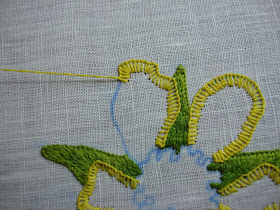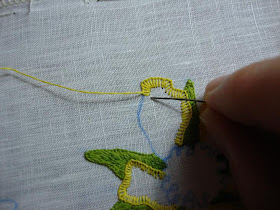As I mentioned before, I'm using buttonhole stitch, or blanket stitch, to define and reinforce the edges of all the flowers, so that they can be cut out at a later stage. With the petals of the first sheet of wood avens to do next, the first step is to buttonhole stitch around each of them.
I'm using three shades of yellow for these flowers: Madeira 0104, 0105 and 0106. The bulk of the petals will be in the middle shade, 0105, so that's what I'm going to use for the buttonhole stitch.
The design outline is clearly marked on the fabric, and will be overstitched; to work the stitch, I start by bringing the needle up just on the outside of the design line:
I then put the needle back through the fabric a little way inside the line, and directly beneath where the thread came up:
I then bring the needle up outside the line again a little further along, but inside the loop of thread:
Pulling this tight gives an 'L' shaped stitch that goes over the design line; a series of them gives a row of overlapping Ls all the way around the edge:
And here are all the petals, buttonholed:
There are a couple of things to note: firstly, the buttonhole stitch 'legs' are going to be overstitched later with split stitch and so won't be seen; this means that I'm not being too fussy about the length of the legs. If these stitches were going to be seen in their entirety in the finished piece I'd be a lot more careful with them, and would probably mark in a second line showing where the needle needed to go back down through the fabric each time, to help me maintain a consistent length. The portion of the stitch along the edge, however, will be seen in the final thing, so I'm trying to keep the lengths of that part of each stitch as even as I can. Once the split stitch is in place, that edging is all that can be seen of the buttonhole stitch, so that it doesn't look like buttonhole stitch at all, but more like stem stitch. Have a look at the sepals - the green bits - that I've already worked to see what I mean.
Secondly, this is the simplest possible form of buttonhole stitch, and there are a wide range of more ornamental variants that you may wish to experiment with. Here, the stitch is serving a practical purpose and isn't forming part of the design other than as a neat and unobtrusive edging, but the fancier forms of the stitch can be very pretty in their own right. Sharon B's Dictionary of Stitches shows all sorts of things you can do with it.





I do appreciate these posts, Ruth.
ReplyDeleteThanks for sharing all your progress
They are coming alone nicely:-)
ReplyDeleteThank you for including all the detail about the construction of the flowers it is most helpful to us beginners:-)
Take care,
Alison.